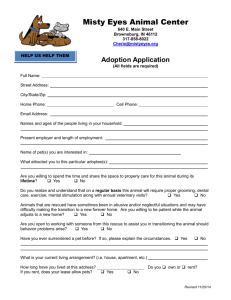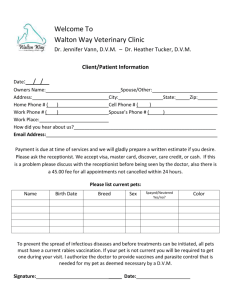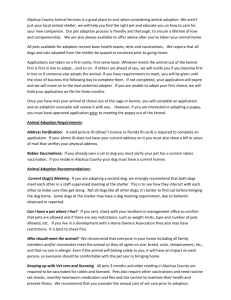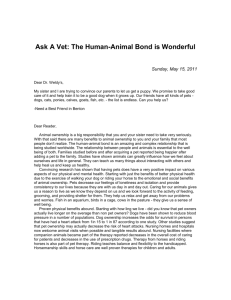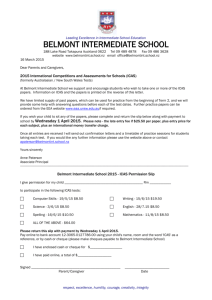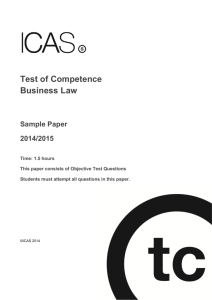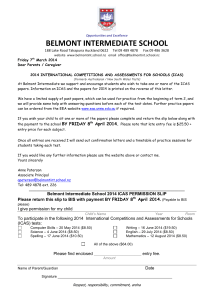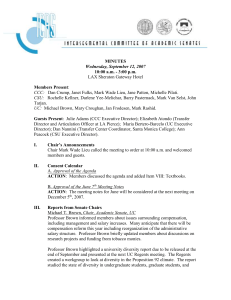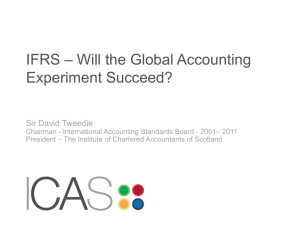ICAS-assessment-standard-3-child-safety-animals-and-pets
advertisement
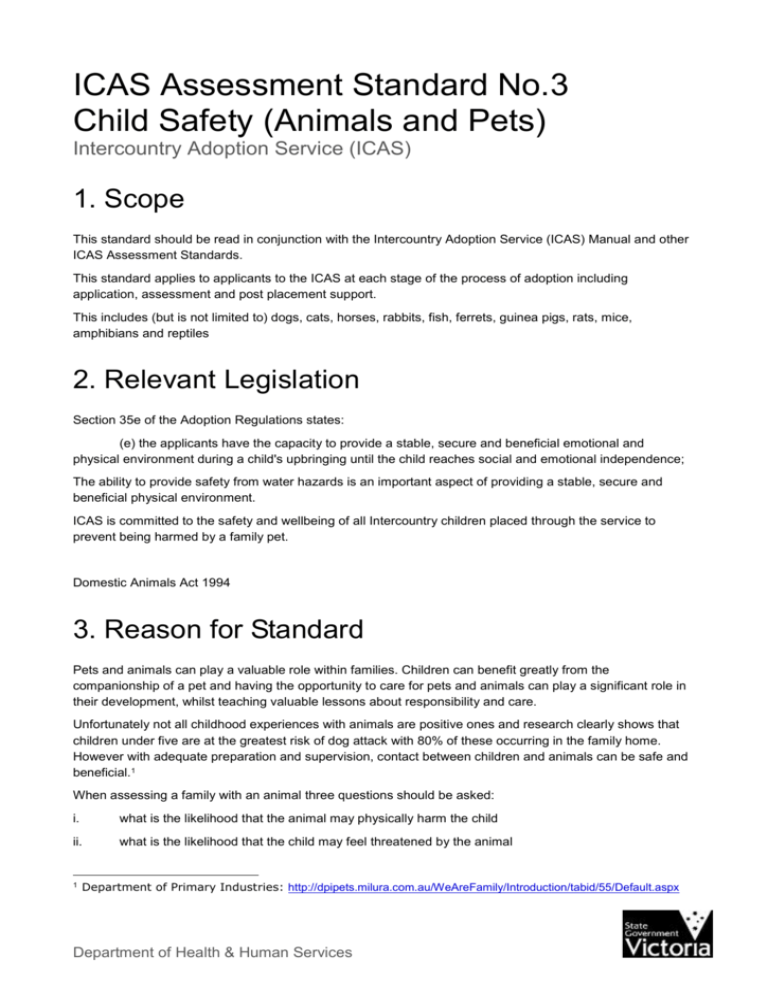
ICAS Assessment Standard No.3 Child Safety (Animals and Pets) Intercountry Adoption Service (ICAS) 1. Scope This standard should be read in conjunction with the Intercountry Adoption Service (ICAS) Manual and other ICAS Assessment Standards. This standard applies to applicants to the ICAS at each stage of the process of adoption including application, assessment and post placement support. This includes (but is not limited to) dogs, cats, horses, rabbits, fish, ferrets, guinea pigs, rats, mice, amphibians and reptiles 2. Relevant Legislation Section 35e of the Adoption Regulations states: (e) the applicants have the capacity to provide a stable, secure and beneficial emotional and physical environment during a child's upbringing until the child reaches social and emotional independence; The ability to provide safety from water hazards is an important aspect of providing a stable, secure and beneficial physical environment. ICAS is committed to the safety and wellbeing of all Intercountry children placed through the service to prevent being harmed by a family pet. Domestic Animals Act 1994 3. Reason for Standard Pets and animals can play a valuable role within families. Children can benefit greatly from the companionship of a pet and having the opportunity to care for pets and animals can play a significant role in their development, whilst teaching valuable lessons about responsibility and care. Unfortunately not all childhood experiences with animals are positive ones and research clearly shows that children under five are at the greatest risk of dog attack with 80% of these occurring in the family home. However with adequate preparation and supervision, contact between children and animals can be safe and beneficial.1 When assessing a family with an animal three questions should be asked: i. what is the likelihood that the animal may physically harm the child ii. what is the likelihood that the child may feel threatened by the animal 1 Department of Primary Industries: http://dpipets.milura.com.au/WeAreFamily/Introduction/tabid/55/Default.aspx Department of Health & Human Services iii. what is the likelihood that an animal may pose a risk of exposure to disease 3.1 Physical harm to the child An assessment should be made both of the likelihood of physical harm as well as the consequence of physical harm. In this context a mouse, rabbit or goldfish would have low consequence. Likelihood is increased as children may behave inappropriately towards an animal having no prior knowledge of safe behaviour. In addition, even the most placid pet may be threatened by the change of having a child live in its environment and respond aggressively. During the first 12 months of placement, considerable effort will be required by the adoptive parents to teach a child about safe behaviours with animals. 3.2 Child’s feelings of threat from an animal Children coming from a developing country, with a background of separation, trauma and institutionalised care may have little or no experience of domestic animals and may be scared or apprehensive around a pet. In some countries, animals are not kept as household pets and as such live on the streets and are treated as pests. If this is the child’s experience, they may not treat the animal in a tolerant manner. 3.3 Animal hygiene and health There are a range of diseases that animals and pets can pass onto children and adults; these include various types of Worms. Good hygiene practices and maintaining the health of your animals will assist in minimising this risk. 4. Requirements Applicants to the Intercountry Adoption Service are expected to prioritise the safety and wellbeing of children in their care and will need to demonstrate their ability to meet the requirements set out in this policy. 4.1 Medium and High Risk Pets Please note that all dogs are considered to be a medium risk, irrespective of the size of the dog, the age of the dog or their history. It is possible that any dog may cause physical harm and even smaller breeds are capable of causing moderate physical consequences. Applicants who own dogs classed as “dangerous” or are of a “restricted breed” should note that this will be a significant issue for consideration at application. Such animals are considered high risk. Other animals that may be highly likely to be considered high risk are some breeds of snake and horses. It is difficult and unlikely to support an applicant having the capacity to provide a secure and beneficial physical environment that includes a high risk pet. ICAS Assessment Standard 3 Child Safety (Animals and pets) 2 Where ICAS assesses an animal to be of medium or high risk, at a minimum ICAS requires that during the first 12 months of placement that there is capacity to physically separate animals and children and to directly supervise all contact between an adopted child and animal. It is necessary for prospective applicants to advise ICAS at the time of application so that associated safety issues can be discussed at the onset of the application process. 4.2 Animal hygiene and health All animals, birds and reptiles kept in a domestic situation must be in a clean and healthy condition. Animal faeces need to be regularly cleared and all animal food and water bowls and litter trays need to be inaccessible to children. All dogs and cats are required to be vaccinated. In addition worming and flea control needs to be undertaken on a regular basis. 4.3 Planning for a child’s contact with a pet Any applicant with a pet should develop a plan of supporting contact between the child and the pet that takes that takes into account that the child may be inexperienced with animals and may feel threatened. Applicants at assessment, reassessment and placement proposal phases will be required to demonstrate a safety plan for the child. The plan may reflect (though not limited to) the following examples: Supervision of children near animals The requirement to supervise or separate a child from a pet, allows for a gradual introduction to each other. Direct supervision requires that an adult is in close range of the child and animal (preferably holding the child or restraining the animal) and can immediately intervene if necessary. When direct supervision cannot be ensured, animals must be physically separated. Sleeping arrangements Animals and pets are not to have access to the child’s bedroom whilst the child is sleeping. Travel Animals and pets must be securely restrained when travelling in a vehicle with a child. Separate fenced off area In relation to outside areas, children need to be able play and explore their new environment without any risk from the household pet. This means that any animals of moderate or high risk need to be physically separated when outside. This can be achieved by way of a dog run or alternatively a fenced off area in which the child can play. These requirements are consistent with those set out in National Standards for Family Day Care.2 5. Procedures 5.1 Key responsibilities and Authorities ICAS is responsible for ensuring the overall responsibility for the implementation of this policy, review of this policy and dissemination of this policy to staff, contractors and applicants to ICAS. 5.2 Assessment Applicants will be required to demonstrate understanding of these requirements at all phases of their application. ICAS staff and/or their contractors will sight and assess that the requirements are met. 2 ‘Animals and Domestic Pets’ Family Day Care Quality Assurance www.ncac.gov.au ICAS Assessment Standard 3 Child Safety (Animals and pets) 3 6. Further Information, Resources and Support ICAS Child Safety (First Aid) Assessment Standard ‘Dogs n Kids’ A Resource Kit for Health Professionals Promoting Dog Ownership and Dog Bite Prevention. Royal Children’s Hospital Safety Centre. ‘We are family’ A guide to nurturing the child and pet relationship from pregnancy to pre-school. Department of primary industries. http://dpipets.milura.com.au/WeAreFamily/Introduction/tabid/55/Default.aspx ‘Child Safety – Children and Animals’ Better health channel website. Victorian State Government. http://www.betterhealth.vic.gov.au/bhcv2/bhcarticles.nsf/pages/Child_safety_children_and_animals?OpenDo cument Safety Centre. Royal Children’s Hospital. Telephone Advisory Line 03) 9345 5085. Email: safety.centre@rch.org.au If you would like to receive this publication in an accessible format, please phone (03) 8608 5700 using the National Relay Service 13 36 77 if required. This document is available as a Word document on the internet at: www.dhs.vic.gov.au/about-the-department/documents-and-resources/policies,-guidelinesand-legislation/intercountry-adoption-service-assessment-standards Authorised and published by the Victorian Government, 1 Treasury Place, Melbourne. January 2015 ICAS Assessment Standard 3 Child Safety (Animals and pets) 4


